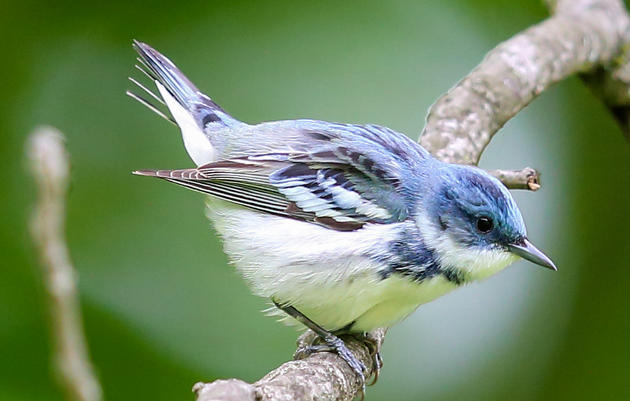The Cerulean Warbler is an officially designated species of “Special Concern” in Connecticut. Across its range, the species has suffered some of the worst declines of all warblers, down 70 percent since 1966.
So why has Audubon Connecticut’s Director of Bird Conservation Corrie Folsom-O’Keefe been spotting so many?
In her role leading Audubon Connecticut’s Lyme Forest Block Conservation Project, Folsom-O’Keefe has spent 40 hours in the Lyme Forest Block Important Bird Area (IBA) this year, surveying more than 1,800-acres of crucial bird habitat. The project’s goal is to engage local land trusts and woodland owners in a dedicated effort to steward land within the IBA for birds and other wildlife.
“The woodlands in this region contain important habitat for the Cerulean Warbler and Wood Thrush, worldwide populations of which are declining drastically,” explains Folsom-O’Keefe. “Part of the issue is deforestation of their wintering grounds in Central and South America. The other issue, here in Connecticut and the Northeast, is a conversion of mature deciduous forest to agricultural or urban areas and fragmentation of remaining habitat.”
Watch the Audubon Connecticut team's training session for landowners and volunteers interested in conducting habitat assessments and management.
Cerulean Warblers prefer to nest in deciduous forests with dense canopy and dense understory (they don’t like mid-story).
In Connecticut, vegetation in the mid-story and understory is frequently sparse, as little light is able to reach the forest floor: the majority of woodlands falls into the same age range (middle-aged) and have a closed canopy. Most of Connecticut’s forests started growing following the abandonment of agriculture and charcoal production roughly 100-150 years ago. However, trees in eastern Connecticut are typically less than 80 years old, a result of widespread forest loss during the Hurricane of 1938.
A mixture of forest age classes and forest types in the landscape provides nesting habitat for a full suite of forest birds with different needs. This is the vision of the Lyme Forest Block Conservation Project and the goal of Audubon Connecticut’s work with land trusts and forest owners.
But if management vis-à-vis the project is still in the works, why so many Cerulean Warblers?
“I’ve counted 16 individuals in my surveys so far this spring,” says Folsom-O’Keefe. “Another birder in Salem has notice Ceruleans in more places than ever before. These are actually incredible numbers for our state. It may be a strange silver lining resulting from the gypsy moth outbreak.”
Oak mortality as a result of Connecticut’s gypsy moth outbreak has certainly been harmful to birds. The oak is the most important tree for caterpillars, which are one of the most important foods for birds who are feeding and raising young.
“If I walk a 200 acre property, there’s a dead oak every 200-300 feet,” estimated Folsom-O’Keefe. “That means that suddenly, where there used to be foliage blocking sunlight from getting to the forest floor, there’s a dead trunk. And in those spots, we see a lot of growth in the understory compared to adjacent woods that remain mostly shaded. In these oak “gaps”, we’re seeing thick patches of blueberry, huckleberry, regenerating tree seedlings and saplings, all of which is great habitat.”
Now that there are hundreds of canopy gaps across the Lyme Forest Block, the species appears to be present in greater numbers.
“Of course there are other possibilities,” says Folsom-O’Keefe, “like the possibility that climate change is driving these birds to nest further north. But the point is the same. What we’re seeing is a natural process that reflects active management by woodland owners–and active management can create more optimal conditions for nesting and migratory birds.”
Management also provides ecosystem services such as carbon sequestration, enhancing water quality, and reducing flooding. Management of woodlands as part of the Lyme Forest Block Conservation Project will not just benefit birds, but create healthier forests for other wildlife and local communities.
The project is already in Phase Two, offering information and training sessions to give landowners and volunteers the opportunity to learn from a certified forester and other ecologists about habitat assessments and management. Next, they’ll be working to create a healthier, most resilient landscape for the future.







